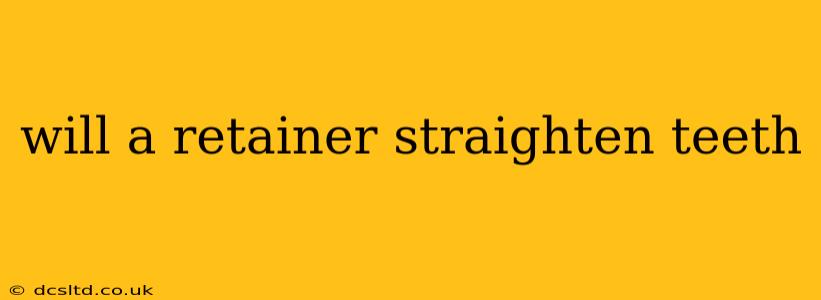Will a Retainer Straighten Teeth? Understanding Retainers and Teeth Straightening
Retainers play a crucial role in orthodontic treatment, but their primary function isn't to straighten crooked teeth. Instead, they're designed to maintain the results achieved through braces, Invisalign, or other teeth-straightening methods. While a retainer can sometimes subtly shift slightly misaligned teeth, it's not a substitute for comprehensive orthodontic treatment. Let's delve deeper into this common question.
What is the Purpose of a Retainer?
The main purpose of a retainer is to hold your teeth in their newly straightened positions after your braces or aligners are removed. Without a retainer, your teeth have a natural tendency to drift back to their original positions over time, negating the effects of your orthodontic work. This is because the bone and gum tissues surrounding your teeth haven't fully remodeled and stabilized to their new positions. Think of it like this: the orthodontic treatment moves the teeth, but the retainer helps the jawbone and gums adapt and solidify the changes.
Can a Retainer Straighten Mildly Crooked Teeth?
While a retainer's primary function is maintenance, it might make minor adjustments to slightly misaligned teeth. If you have very minor crowding or spacing issues, a retainer could potentially nudge these teeth into a more aesthetically pleasing position. However, this is not guaranteed and depends on several factors including the severity of the misalignment and the type of retainer used.
What Types of Retainers Are There, and How Do They Work?
There are several types of retainers, each with its own mechanism:
-
Fixed (bonded) retainers: These are thin wires cemented to the back of your teeth, usually on the lower arch. They're virtually invisible and provide excellent long-term stability, preventing any significant movement. They are not designed to actively straighten teeth.
-
Removable retainers: These are custom-made plastic appliances that you can take in and out of your mouth. They come in various forms, including clear plastic aligners (similar to Invisalign but for retention) and Hawley retainers (which have a wire arch and a plastic base). While more flexible, they require diligent wear to be effective.
-
Essix retainers: These are clear, removable retainers that are often used after Invisalign treatment. Similar to removable retainers, they primarily maintain the position of the teeth and offer only minimal potential for slight adjustments.
How Long Do I Need to Wear a Retainer?
The length of time you need to wear a retainer depends on several factors, including your age, the severity of your initial misalignment, and your dentist's recommendations. It's crucial to follow your orthodontist's instructions carefully. Long-term retainer wear is often recommended, potentially for years or even indefinitely, especially for fixed retainers.
What if My Teeth Shift After Braces, Even With a Retainer?
If you notice your teeth shifting even while wearing a retainer, it's vital to consult your orthodontist immediately. There could be underlying issues requiring further attention. It's important to remember that retainers aren't a one-size-fits-all solution and individual results vary.
Can I Use a Retainer to Straighten My Teeth Without Prior Orthodontic Treatment?
No. A retainer is not a substitute for braces or Invisalign. Attempting to straighten teeth significantly misaligned with only a retainer is unlikely to be successful and could potentially damage your teeth and gums. Proper orthodontic treatment addresses the underlying skeletal and dental issues causing misalignment.
In conclusion, while a retainer might make minor adjustments to slightly crooked teeth, it's fundamentally a maintenance appliance. For significant teeth straightening, you need professional orthodontic treatment from a qualified orthodontist or dentist. Always consult a dental professional for personalized advice and treatment.
